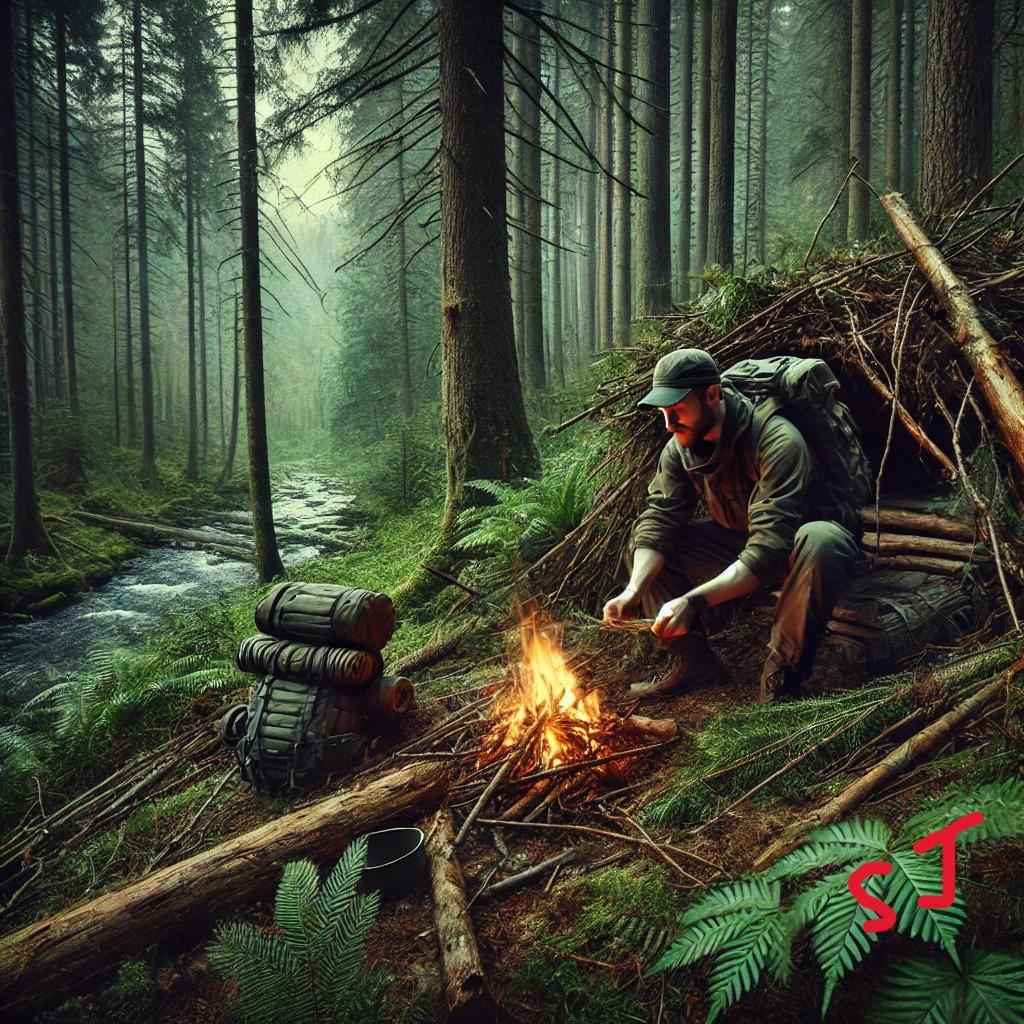Learn how to survive if the shit hit the fan.
-
Public Group
-
3 Posts
-
3 Photos
-
0 Videos
-
0 Reviews
-
Live Style
 Shon Jimenez
Shon Jimenez
 Janusz Krawczak
Janusz Krawczak
 Barry Yue
Barry Yue
Recent Updates
-
If I were lost in the woods miles away from the nearest road, I’d follow a structured survival strategy focused on staying calm, assessing my situation, and taking deliberate actions to ensure my safety and eventual rescue.
1. Stay Calm and Assess the Situation
Panic is your worst enemy in a survival situation. I’d take a deep breath, sit down, and think logically:
- How did I get here? Can I retrace my steps?
- Do I have a map, compass, or GPS? If so, I’d try to determine my location.
- How much daylight is left? This will dictate whether I move or set up camp.
- What supplies do I have? Check for water, food, tools, and first aid items.
2. Determine Priorities Using the Rule of Threes
The Rule of Threes helps prioritize survival needs:
- You can survive 3 minutes without air. (Not a concern in most woods.)
- You can survive 3 hours without shelter in harsh weather.
- You can survive 3 days without water.
- You can survive 3 weeks without food.
Since exposure is a primary killer, shelter and warmth come first if conditions are cold or wet.
3. Mark My Location
- I’d break branches, create a visible marker (such as an "X" on the ground), or pile rocks to note my last known location.
- If I have a whistle, I’d blow three blasts—an international distress signal.
4. Decide Whether to Stay or Move
- If I believe rescuers might be searching for me, I’d stay put and make myself visible.
- If I must move, I’d look for signs of civilization, roads, power lines, rivers (which often lead to towns), or clearings.
5. Build a Shelter
If nightfall is approaching, I’d build a simple shelter:
- A lean-to using tree branches and leaves for insulation.
- A debris hut, covering a frame with leaves, moss, and pine needles.
- A rock overhang or fallen tree can provide natural protection.
6. Find Water
- I’d look for streams or rivers, but avoid stagnant water.
- If needed, I’d collect rainwater or dew using leaves or clothing.
- I’d purify water by boiling, using purification tablets, or a filter (if available).
7. Signal for Help
- Build a smoky fire using green leaves or damp wood.
- Use a mirror, shiny object, or phone screen to reflect sunlight.
- Create large symbols (like "SOS" using rocks or logs in an open area.
8. Find Food (If Necessary)
Food is not an immediate priority, but if needed, I’d:
- Look for berries and edible plants (avoiding unknown or brightly colored ones).
- Catch small animals with traps or look for insects.
- Fish if I find a water source.
9. Travel Smartly
If I decide to move:
- I’d follow running water downstream—often leading to civilization.
- Avoid thick forests and difficult terrain to conserve energy.
- Walk in one direction rather than wandering aimlessly.
10. Stay Positive
Mental strength is as important as physical endurance. I’d stay hopeful, remember survival skills, and focus on each small victory.
Final Thought
Survival is about calm thinking, smart decisions, and using what’s available. The key is to stay put if rescue is likely, and move strategically if necessary. Would you like survival tips for specific terrains or conditions?
#SurvivalTips #WildernessSurvival #LostInTheWoods #SurviveAndThrive #OutdoorSkills #EmergencyPreparedness #Bushcraft #StayAlive #SurvivalHacks #NatureSkills #WildernessAdventure #OutdoorLife #SurvivalGuide #BePrepared #SelfReliance #SurvivalMindset #SurvivalTraining #SurvivalGear #WildlifeExploration #HikingSafetyIf I were lost in the woods miles away from the nearest road, I’d follow a structured survival strategy focused on staying calm, assessing my situation, and taking deliberate actions to ensure my safety and eventual rescue. 1. Stay Calm and Assess the Situation Panic is your worst enemy in a survival situation. I’d take a deep breath, sit down, and think logically: - How did I get here? Can I retrace my steps? - Do I have a map, compass, or GPS? If so, I’d try to determine my location. - How much daylight is left? This will dictate whether I move or set up camp. - What supplies do I have? Check for water, food, tools, and first aid items. 2. Determine Priorities Using the Rule of Threes The Rule of Threes helps prioritize survival needs: - You can survive 3 minutes without air. (Not a concern in most woods.) - You can survive 3 hours without shelter in harsh weather. - You can survive 3 days without water. - You can survive 3 weeks without food. Since exposure is a primary killer, shelter and warmth come first if conditions are cold or wet. 3. Mark My Location - I’d break branches, create a visible marker (such as an "X" on the ground), or pile rocks to note my last known location. - If I have a whistle, I’d blow three blasts—an international distress signal. 4. Decide Whether to Stay or Move - If I believe rescuers might be searching for me, I’d stay put and make myself visible. - If I must move, I’d look for signs of civilization, roads, power lines, rivers (which often lead to towns), or clearings. 5. Build a Shelter If nightfall is approaching, I’d build a simple shelter: - A lean-to using tree branches and leaves for insulation. - A debris hut, covering a frame with leaves, moss, and pine needles. - A rock overhang or fallen tree can provide natural protection. 6. Find Water - I’d look for streams or rivers, but avoid stagnant water. - If needed, I’d collect rainwater or dew using leaves or clothing. - I’d purify water by boiling, using purification tablets, or a filter (if available). 7. Signal for Help - Build a smoky fire using green leaves or damp wood. - Use a mirror, shiny object, or phone screen to reflect sunlight. - Create large symbols (like "SOS" using rocks or logs in an open area. 8. Find Food (If Necessary) Food is not an immediate priority, but if needed, I’d: - Look for berries and edible plants (avoiding unknown or brightly colored ones). - Catch small animals with traps or look for insects. - Fish if I find a water source. 9. Travel Smartly If I decide to move: - I’d follow running water downstream—often leading to civilization. - Avoid thick forests and difficult terrain to conserve energy. - Walk in one direction rather than wandering aimlessly. 10. Stay Positive Mental strength is as important as physical endurance. I’d stay hopeful, remember survival skills, and focus on each small victory. Final Thought Survival is about calm thinking, smart decisions, and using what’s available. The key is to stay put if rescue is likely, and move strategically if necessary. Would you like survival tips for specific terrains or conditions? #SurvivalTips #WildernessSurvival #LostInTheWoods #SurviveAndThrive #OutdoorSkills #EmergencyPreparedness #Bushcraft #StayAlive #SurvivalHacks #NatureSkills #WildernessAdventure #OutdoorLife #SurvivalGuide #BePrepared #SelfReliance #SurvivalMindset #SurvivalTraining #SurvivalGear #WildlifeExploration #HikingSafety0 Comments 0 Shares 636 Views 0 Reviews 2
2 Please log in to like, share and comment!
Please log in to like, share and comment!
More Stories
No data to show
No data to show
No data to show
No data to show
No data to show






